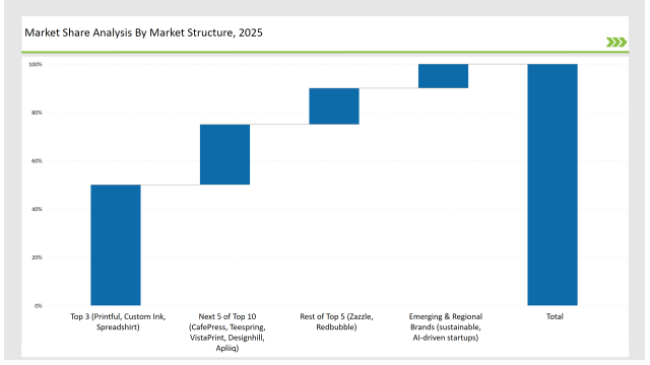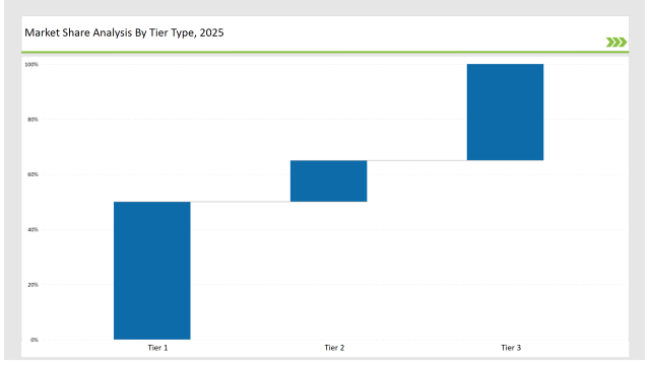The custom T-shirt printing market is on a growth spree. Consumers, businesses, and influencers are all scrambling to create fashionable statements customized from scratch. In fact, increased brand identity and self-expression for events have started to fuel market growth. The quality, durability, and price-effective prints are more developed for printing technologies such as DTG, screen printing, and heat transfer.
In terms of fulfillment networks, print-on-demand services, and large design libraries, Printful, Custom Ink, and Spreadshirt have a significant share of the market, making up 50%. This means 35% of the remaining regional players and local printing companies, while emerging digital-first platforms with AI-driven design tools and eco-friendly printing solutions take the rest of the share at 15%.
Explore FMI!
Book a free demo
| Market Segment | Industry Share (%) |
|---|---|
| Top 3 (Printful, Custom Ink, Spreadshirt) | 50% |
| Rest of Top 5 (Zazzle, Redbubble) | 15% |
| Next 5 of Top 10 (CafePress, Teespring, VistaPrint, Designhill, Apliiq) | 25% |
| Emerging & Regional Brands (sustainable, AI-driven startups) | 10% |

The custom T-shirt printing market in 2025 is moderately fragmented, with numerous small and medium-sized enterprises driving competition. While companies like Printful and Custom Ink lead in online and bulk orders, a vast number of local businesses and digital entrepreneurs create a dynamic and competitive environment. The market’s accessibility and demand for personalized apparel continue to fuel its expansion.
The specialty T-shirt printing industry operates through a number of sales channels. E-commerce sites and online platforms account for 60%; print-on-demand services, social media engagement, and influencer partnerships are key. Physical retail shops and print stores account for 25% from in-person consultations and volume orders. Corporate volume printing and business branding services should have 10%, driving to promotional products and uniforms. 5% specialty niche markets and independent artists who sell custom designs for any of the latest fashion trends or cultural movements.
The custom T-shirt printing market can be segmented into four types of products. They include; direct-to-garment, screen printing, sublimation, and heat transfer printing. The most popular one in the market is DTG that holds a 40% share. The reason is that DTG is in preference when intricate full-color designs have to be printed on demand. Screen printing takes up 30% market share because this method is widely applied in mass production as it is relatively cheaper and long-lasting. Sublimation is 20%, for all-over prints and polyester materials. Heat transfer printing is 10%, very flexible and inexpensive, and hence preferred by small businesses and do-it-yourself customizers.
2024 has been the game-changer year for the custom T-shirt printing market. It is driven by technological innovation, sustainability initiatives, and changing fashion trends. There are key players:

| Tier Type | Tier 1 |
|---|---|
| Example of Key Players | Printful, Custom Ink, Spreadshirt |
| Market Share% | 50% |
| Tier Type | Tier 2 |
|---|---|
| Example of Key Players | Zazzle, Redbubble |
| Market Share% | 15% |
| Tier Type | Tier 3 |
|---|---|
| Example of Key Players | Regional brands, AI-driven startups |
| Market Share% | 35% |
| Brand | Key Focus Areas |
|---|---|
| Printful | Sustainable fabrics & water-based ink solutions |
| Custom Ink | Fast fulfillment & high-volume order efficiency |
| Spreadshirt | AI-powered design recommendations |
| Zazzle | Influencer-led collaborations & niche apparel |
| Redbubble | Independent artist support & unique collections |
| Emerging Brands | AI-generated design tools & eco-friendly printing |
The road ahead for the custom apparel marketplace through T-shirt printing is quite positive, especially with the increase in digital progressions, greater sustainability efforts, and changes in consumer behavior. Innovation will come from AI-based customization tools, biodegradable inks, and faster production methods. Print-on-demand services will be improved as an effortless means for creators and businesses to monetize their custom apparel. Sustainability will be the feature, where brands will invest in recyclable material and green manufacturing. Personalization, technological convenience, and sustainability will define the future of the industry - for individual expression and for mass branding.
Leading brands such as Printful, Printify, and CustomInk collectively hold around 50% of the market.
Local custom print shops and small-scale businesses contribute approximately 35% of the market.
Startups specializing in direct-to-garment (DTG) and eco-friendly printing hold about 10% of the market.
Private labels from fashion brands and e-commerce retailers hold around 5% of the market.
High for companies controlling 50%+, medium for 35-50%, and low for those under 30%.
Coffea Arabica (Coffee) Seed Oil Market - Trends, Growth & Forecast 2025 to 2035
Dog Collars, Leashes & Harnesses Market Analysis by Dog Collars, Dog Leash, Dog Harness, Material Type, Distribution Channel and Region Through 2025 to 2035.
Cat Toys Market Analysis by Product Type, Material Type, Sales Channel, End-User, Application and Region Through 2035
Baby Swing Market Analysis by Seat Type, Sales Channel, End User, and Region, Forecast through 2035
Anti-Pollution Hair Care Market Analysis by Product Type, Packaging Type, and Region - Trends, Growth & Forecast 2025 to 2035
Electric Toothbrush Market by Product Type, Price, Head Movement, Sales Channel, and Region - Trends, Growth & Forecast 2025 to 2035

Thank you!
You will receive an email from our Business Development Manager. Please be sure to check your SPAM/JUNK folder too.